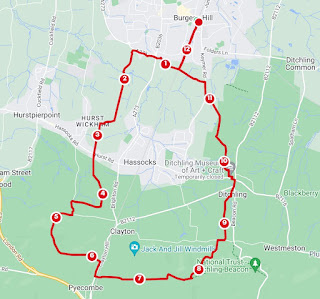Art of Walking
So there wasn't a walk this Friday. Two excuses; The weather was awful with wind, showers including hail, prohibitive mud and lots to fit in before catching the train to Liverpool with the littlens after an early tea.
These sound like lame reasons and, in truth, I feel weirdly robbed, so much so that I will try and do two walks this coming week.
And so I digress. It's no revelation that I do not go walking purely for health benefits. If I did, I might go a little faster. It wasn't the point but a by-product. Clearly it has been positive for my physical and mental well-being. It's also not true that I walk to be deep in the countryside. Sussex is hardly wilderness and you're never far from urbanisation or evidence of human impact. Appreciation of the environment is not always of the bucolic. The outdoors can be lonely, depressing, dreary, unpleasant and unrelenting place and that feels valid.
I might explain by saying that I actually like a bit of 'bleak'. I'm not necessarily a seeker of sensory drama. I don't like to repeat myself too soon but I know it is possible to walk the same route and see it in a different way each time. The explanations are as obvious as having a bad day, the weather, the time, the quality of light, the hope of a snack and dwindling energy levels. Equally, one person might perceive a walk in a different way to the next. What does the activity of walking mean to one person and how do they relate to the outdoors?
Some answers I can offer are rooted in my past and, I guess, my human condition. In a previous life, I might point out that I hail from darkest Suffolk, where things are often flat but the countryside has always felt industrially agricultural in areas. Alive with birdsong, the path can also be deeply unromantic, nestled amongst discarded beets, the churn of the plough, the prevailing wind of pigs and the stride and hum of the electricity pylon.
Also, in a previous student incarnation, I have been made aware of the artistic activity of the Situationists. Without being too pretentious, I can relate to experiencing and understanding an environment through a method of 'drift'. To move without purpose, being aware of ambience of areas and mapping the temporary nature of a place. You might call this a production of the 'psychogeography' of a landscape. This interpretation realises that while my comprehension of the physical reality of my walk is necessarily limited, I've probably also decided what kind of experience I've had. My memory and knowing of a route is constructed by the nature of elements in particular places.
It's not all the here and now. My post-punk amble around Burgess Hill is coloured also by a deep love of flora and fauna but also by the weight I feel of past human activity and a longer geological influence upon a landscape. Shortest book review ever: I recommend Richard Mabey The Unofficial Countryside with Mary Newcomb's cover of 'The Pylon'. Both express everything I appreciate about often fringe environments and chime with my experience of Suffolk as transposed to Sussex.


Comments
Post a Comment